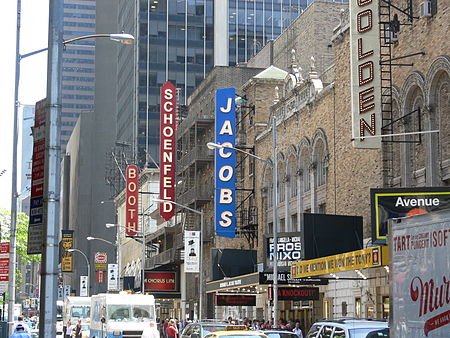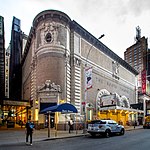The Richard Rodgers Theatre (formerly Chanin's 46th Street Theatre and the 46th Street Theatre) is a Broadway theater at 226 West 46th Street in the Theater District of Midtown Manhattan in New York City. Opened in 1925, it was designed by Herbert J. Krapp and was constructed for Irwin Chanin. It has 1,319 seats across two levels and is operated by the Nederlander Organization. Both the facade and the auditorium interior are New York City landmarks.
The facade is divided into two sections. The eastern section, containing the auditorium, is designed in the neo-Renaissance style with white brick and terracotta. The auditorium's ground floor has an entrance under a marquee, above which is a loggia of three double-height arches, as well as a entablature and balustrade at the top. The facade's western section, comprising the stage house, is seven stories high and is faced in buff-colored brick. The auditorium contains neo-Renaissance detailing, steep stadium seating in the orchestra level, a large balcony, and a shallow domed ceiling. Due to the slope of the seats, the rear of the orchestra is one story above ground. There are also box seats near the front of the auditorium on two tiers.
Chanin's 46th Street Theatre was the first Broadway theater developed by Irwin S. Chanin, and it was immediately leased to the Shubert brothers when it opened. The Shuberts bought the building outright in 1931 and renamed it the 46th Street Theatre. In 1945, the theater was taken over by Robert W. Dowling of the City Investing Company. In 1960, it was purchased by the producer Lester Osterman, who sold it to producers Stephen R. Friedman and Irwin Meyer in 1978. The Nederlander Organization purchased the venue in 1981 and renamed it to honor the composer Richard Rodgers in 1990. Over the years, the Richard Rodgers has hosted eleven Tony Award-winning productions: Guys and Dolls, Redhead, How to Succeed in Business Without Really Trying, 1776, Raisin, Nine, Fences, Lost in Yonkers, In the Heights, and Hamilton. Other long-running shows at the theater have included Panama Hattie and One Touch of Venus.












